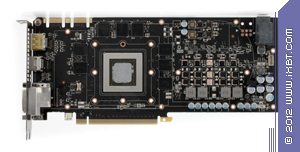ASUS GeForce GTX 680 DirectCu II TOP, Gainward GeForce GTX 680 Phantom, Zotac GeForce GTX 680 AMP! Edition Graphics Cards
|
Today we shall review three graphics cards from ASUS, Gainward, and Zotac, all based on the GeForce GTX 680 GPU.
Specifications
ASUS GeForce GTX 680 DirectCu II TOP
- GPU: GeForce GTX 680 (GK104)
- Interface: PCIe 3.0 x16
- GPU clock rate (ROPs/shaders): 1137–1201 MHz (the standard is 1006–1110 MHz)
- Memory clock rate, physical (effective): 1502 (6008) MHz (standard)
- Memory bus: 256-bit
- Stream processors: 1536
- Texture units: 128 (BLF/TLF/ANIS)
- ROP units: 32
- Dimensions: 300x130 mm, 3 slots
- PCB color: dark brown
- Peak power consumption (3D/2D/standby): 205–222/85/65 W
- Output connectors: DVI-I, DVI-D, HDMI 1.4a, DisplayPort 1.2
- Multi-GPU mode: hardware SLI
|
 |
Gainward GeForce GTX 680 Phantom
- GPU:GeForce GTX 680 (GK104)
- Interface: PCIe 3.0 x16
- GPU clock rate (ROPs/shaders): 1084–1150 MHz (the standard is 1006–1110 MHz)
- Memory clock rate, physical (effective): 1575 (6300) MHz (the standard is 1502 (6008) MHz)
- Memory bus: 256-bit
- Stream processors: 1536
- Texture units: 64 (BLF/TLF/ANIS)
- ROP units: 32
- Dimensions: 254x112 mm, 2,5 slots
- PCB color: black
- Peak power consumption (3D/2D): 200–210/83/63 W
- Output connectors: DVI-I, DVI-D, HDMI 1.4a, DisplayPort 1.2
- Multi-GPU mode: hardware SLI
|
 |
Zotac GeForce GTX 680 AMP! Edition
- GPU: GeForce GTX 680 (GK104)
- Interface: PCIe 3.0 x16
- GPU clock rate (ROPs/shaders): 1110–1176 MHz (the standard is 1006–1110 MHz)
- Memory clock rate, physical (effective): 1652 (6608) MHz (the standard is 1502 (6008) MHz)
- Memory bus: 256-bit
- Stream processors: 1536
- Texture units: 64 (BLF/TLF/ANIS)
- ROP units: 32
- Dimensions: 267x125 mm, 2.5 slots
- PCB color: black
- Peak power consumption (3D/2D): 202–213/82/65 W
- Output connectors: DVI-D, DVI-I, HDMI 1.4a, DisplayPort 1.2
- Multi-GPU mode: hardware SLI
|
 |
Comparison with the reference design, front view
| ASUS GeForce GTX 680 DirectCu II TOP |
Reference NVIDIA GeForce GTX 680 |
 |
 |
| Gainward GeForce GTX 680 Phantom |
Reference NVIDIA GeForce GTX 680 |
 |
 |
| Zotac GeForce GTX 680 AMP! Edition |
Reference NVIDIA GeForce GTX 680 |
 |
 |
Comparison with the reference design, rear view
| ASUS GeForce GTX 680 DirectCu II TOP |
Reference NVIDIA GeForce GTX 680 |
 |
 |
| Gainward GeForce GTX 680 Phantom |
Reference NVIDIA GeForce GTX 680 |
 |
 |
| Zotac GeForce GTX 680 AMP! Edition |
Reference NVIDIA GeForce GTX 680 |
 |
 |
All graphics cards but Zotac's are custom products. The Zotac GeForce GTX 680 AMP! Edition has a reference PCB although it's been produced by the third-party—PC Partner.
The ASUS GeForce GTX 680 DirectCu II TOP has the reference memory chip layout but everything else has been customized. The VRM has 4 phases for the memory and 6 phases for the GPU and offers accurate voltage tuning via the Digi+ power controller. The 8-pin and 6-pin supplementary power connectors are placed next to each other (unlike the reference 'double-decker'). The 8-pin connectors used instead of the reference 6-pin one improves stability at higher clock rates.
The Gainward GeForce GTX 680 Phantom is not as customized. The 8-pin and 6-pin supplementary power connectors are stacked. The VRM has 2 phases for the memory and 6 phases for the GPU.
All three share a standard set of output connectors: Dual Link DVI-I, Dual Link DVI-D, HDMI (transmits both audio and video), and Display Port. All video outputs can be used at the same time, as NVIDIA's new GeForce GTX 600 series supports up to four displays simultaneously.
Maximum resolutions and frequencies:
- 240 Hz maximum refresh rate
- 2048 x 1536 @ 85 Hz max. analog (VGA) resolution
- 2560 x 1600 @ 60 Hz max. digital (DVI) resolution (for Dual Link DVI-D)
Write a comment below. No registration needed!
|
|
 |
|
|
|
